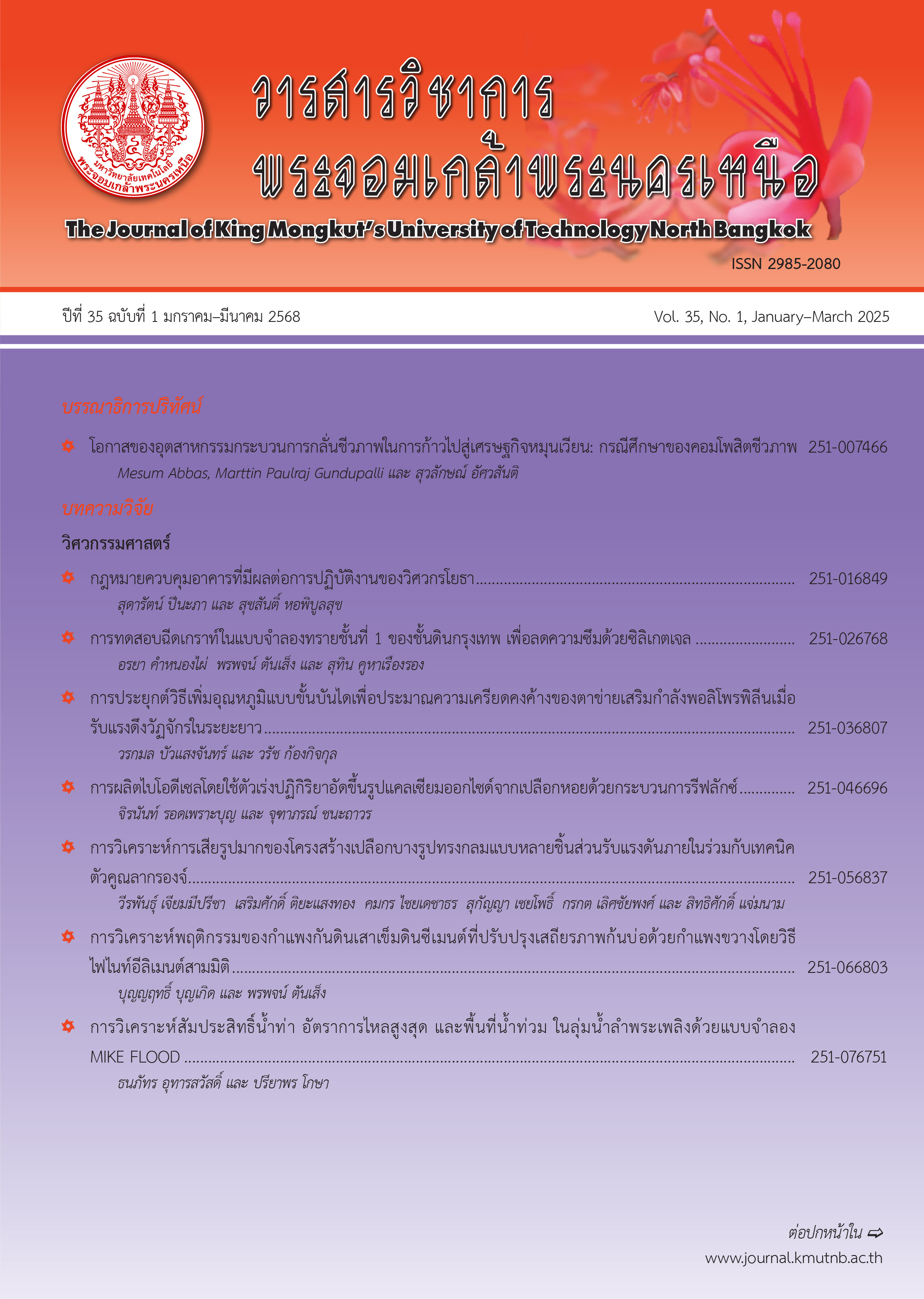อิทธิพลของชนิดของถ่านและชนิดของวัสดุที่ใช้ทำรังผึ้งต่อประสิทธิภาพเชิงความร้อนของเตาหุงต้มประสิทธิภาพสูง
Main Article Content
บทคัดย่อ
งานวิจัยนี้มีวัตถุประสงค์เพื่อศึกษาอิทธิพลชนิดของถ่านไม้และชนิดของวัสดุที่ใช้ทำรังผึ้งต่อประสิทธิภาพเชิงความร้อนของเตาหุงต้มประสิทธิภาพสูง ในการศึกษาวิจัยนี้ทำการหาค่าความร้อนของถ่านไม้จำนวน 10 ชนิด คือ ถ่านไม้มะม่วง ถ่านไม้สะแกนา ถ่านไม้กระบก ถ่านไม้ยางนา ถ่านไม้มะขาม ถ่านไม้กระถิน ถ่านไม้ประดู่ ถ่านไม้ยูคาลิปตัส ถ่านไม้ไผ่ และถ่านไม้ยางพารา โดยใช้เครื่องบอมบ์แคลอริมิเตอร์ IKA C2000 ในส่วนของรังผึ้งเตาหุงต้มประสิทธิภาพสูงที่มีการเปลี่ยนแปลงวัสดุ คือ รังผึ้งที่ทำจากดินเหนียว (รังผึ้งดั้งเดิม) และรังผึ้งที่ทำจากเหล็กหล่อ โดยรังผึ้งที่ทำจากเหล็กหล่อที่มีค่าการนำความร้อน 71–80.4 วัตต์ต่อเมตรเคลวิน ซึ่งจำนวนรูรังผึ้งเท่ากับ 44 รู เส้นผ่านศูนย์กลางของรูรังผึ้งด้านบนและด้านล่าง เท่ากับ 13 และ 14 มิลลิเมตร ตามลำดับ และรังผึ้งมีความหนา 30 มิลลิเมตร ทำการทดสอบด้วยวิธีต้มน้ำเดือดที่แวดล้อมเดียวกัน จากการศึกษาพบว่า ถ่านไม้กระถินมีค่าความร้อนสูงสุด เท่ากับ 31.157 กิโลจูลต่อกิโลกรัม เตาหุงต้มประสิทธิภาพสูงที่ใช้เหล็กหล่อทำรังผึ้งและใช้ถ่านไม้กระถินเป็นเชื้อเพลิง มีประสิทธิภาพเชิงความร้อนสูงสุดเท่ากับ 43.97 เปอร์เซ็นต์ และมีเปอร์เซ็นต์การประหยัดพลังงานสูงขึ้น 4.64 เปอร์เซ็นต์ จากการวิเคราะห์พบว่า ชนิดของถ่านไม้และชนิดของวัสดุที่ใช้ทำรังผึ้งมีผลต่อประสิทธิภาพเชิงความร้อนของเตาหุงต้มประสิทธิภาพสูง
Article Details

อนุญาตภายใต้เงื่อนไข Creative Commons Attribution-NonCommercial-NoDerivatives 4.0 International License.
บทความที่ลงตีพิมพ์เป็นข้อคิดเห็นของผู้เขียนเท่านั้น
ผู้เขียนจะต้องเป็นผู้รับผิดชอบต่อผลทางกฎหมายใดๆ ที่อาจเกิดขึ้นจากบทความนั้น
เอกสารอ้างอิง
M. Wichangarm, and T. Sriveerakul, “Simulation of air flow through a high efficiency cooking stove’s grate using CFD,” Journal of Science and Technology Ubon Ratchathani University, vol. 14, no. 2, pp. 24–34, 2012 (in Thai).
Kroobannok (2022), What is High Efficiency Cooking Stove. Bangkok, Thailand. [Online] (in Thai). Available: https://www.kroobannok. com/90330
Research and service on energy center UBU. Thailand, “Final report cooperation between Thailand and neighboring countries to study of high efficiency cooking stove in the Lao,” 2006.
Museum Siam (2022), Museum Pop Culture. Bangkok, Thailand. [Online] (in Thai). Available: https://www.museumsiam.org/ km-detail.php?CID=200&CONID=5764
Office of the Ministry of Energy (2020), High Efficiency Cooking Stove Production Project. Bangkok, Thailand. [Online] (in Thai). Available: https://ppp.energy.go.th/wp-content/ uploads/2020/04/แบบเตาหุุงต้้มประสิิทธิิภาพสูู ง.pdf
T. Chaichana, M. Ali, and M. Longsaman, “The study of thermal efficiency of household cooking stove,” Journal of Science and Technology Mahasarakham University, vol. 32, no. 52, pp. 626–630, 2013 (in Thai).
S. Limsuwan and S. Lee, “Efficiency improvement of the super cooking stove process,” Journal of Academics Ubon Ratchathani University, vol. 12, no. 2, pp. 17–28, 2010 (in Thai).
A. Koopmans, “Thailand improved charcoal bucket stove technology and dissemination,” Regional energy resources information center, Asian institute of technology, 1993, pp. 1–57.
Research and service center on energy mechanical energy, Ubon Ratchathani University, “Development and promotion of high efficiency cooking stove,” Manual of manufacturing processes and application for high efficiency cooking stove, 2006.
B. Krittacom, P. Waramitr, and P. Tongbai, “Effect of honeycomb thickness of charcoal cooking stove on thermal efficiency,” presented at the 7th International Conference on Mechanical Engineering (ICOME 2016), Chiang Mai, 2016 (in Thai).
T. Sriveerakul, M. Wichangarm, and N. Priyapai, “Prediction of airflow in the high efficiency cooking stove,” presented at the 29th Conference of Mechanical Engineering Network of Thailand, Nakhon Ratchasima, 2015 (in Thai).
S. Worrasri, N. Lonkhonthod, B. Chuenjit, and W. Insorn, “The development of clay for a production of high efficiency stove,” Academic Journal of Phetchaburi Rajabhat University, vol. 6, no. 1, pp. 73-81, 2016 (in Thai).
A. Chomcharn, “Improved biomass cooking stove for household use,” Report submitted to the National Energy Administration, Ministry of Science, Technology and Energy, Bangkok, 1984.
M. Wichangarm, T. Sriveerakul, and S. Aphornratana, “Numerical simulation of airflow in the high efficiency cooking stove,” presented at the 4th International Engineering Conference 2012 (KKU-IENC 2012), Khonkaen, 2012, pp. 24–30 (in Thai).
A. Phromdon, and T. Sriveerakul, “Thermal efficiency test of high efficiency cooking stove (HECS) with variations on the number and diameter ratio of the grate’s holes,” presented at the 26th Conference of Mechanical Engineering Network of Thailand, Chiang Rai, 2012 (in Thai).
W. Lamdoun, N. Onslung, and N. Pipatpiboon, “The configuration of grate affect to the behavior of airflow in the high efficiency cooking stove,” SWU Engineering Journal, vol. 14, no. 1, pp. 78–87, 2019 (in Thai).
Merhods.bioenergylists.org. (2009, October). The Water Boiling Test Version 4.1.2 Cookstove Emission and Efficiency in a Controlled Laboratory Setting. DRAFT. [Online]. Available: https://pciaonline.org/files/WBT4.1.2_0_0.pdf

